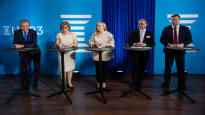The next parliamentary elections will be held in four months, but how do sports and exercise appear in the parties’ election themes?
On Thursday, Urheilu gathered the presidents or vice-presidents of the parliamentary parties in the Great Presidential Exam to discuss top sports, exercise and immobility.
The problems of immobility have been talked about for years, but the crisis seems to be swelling and affecting everyone from children to the elderly. Recent Move measurements published in December revealed that up to 40 percent of students in grades 5-8 have a level of physical activity that makes it difficult to cope with everyday life.
According to UKK institute’s calculations (you switch to another service) Immobility costs Finland up to 3.2 billion euros annually. For example, the loss of income taxes from Poti is estimated to be around 1,843 million euros, 419 million euros from institutional care for the elderly and 56 million euros from sick leave.
This is how the party leaders would address the problem
The party leaders all agreed that the government should do more to solve the problems caused by immobility.
– It is a matter for society as a whole that Finland is in better shape. We need to get the Ministry of Social Affairs and Health involved, the Ministry of Defense involved, the Ministry of Labor and the Economy, the vice-chairman of the SDP Ville Skinnari started
Chairman of Basic Finns Riikka Purra was most concerned about the children’s immobility.
– I propose that physical education taught in schools should be increased and schoolyards should be made more active.
The coalition Petteri Orpo agreed with Purra that the most important thing would be to increase the exercise of children and young people.
– I would add more hobby opportunities in connection with schools. This could be done together with municipalities and clubs, Orpo saw.
Chairman of the Left Alliance Lee Andersson like Purra, would invest in schoolyards.
– More equipment and better sports fields. Yards should be developed so that they become local exercise places for anyone outside of the school day.
Like Andersson, the chairman of the Greens Maria Ohisalo proclaimed the importance of physical activity also on school trips.
– Routes must be safe. Exercise should be introduced into everyday life in different ways, so that it starts from childhood and remains throughout life, Ohisalo suggested and also highlighted the excursion destinations that have increased the popularity of families, the national parks.
RKP chairman Anna-Maja Henriksson was on the same lines as his colleagues. He would invest in everyday exercise for adults and facilitating exercise opportunities for the elderly.
Henriksson was ready to increase exercise for children and young people in other lessons as well.
– Not like sitting in a room, but being outside, moving around and getting to know society. The Finnish model of the hobby could also be extended to the second degree.
Chairman of the Christian Democrats Sari Essayahin the suggestion to increase exercise was quite concrete.
– An active lifestyle is adopted as a child and young person. So let’s start with the baby, let’s put a ball in the maternity pack.
Chairman of Liike Nyt Harry Harkimo would start increasing exercise in schools and companies.
– According to the Danish model, there is an hour of exercise every day. We should increase school physical education for more than one, two or three hours. When the retirement age is being extended all the time, companies should be included. Efficiency increases and it is easier to raise the retirement age when employees are in good health.
Vice-chairman of the center and minister responsible for sports Petri Honkonen was especially concerned about the elderly.
– A good way is counseling and guidance in sports activities in connection with health care. However, the principle is that the state does not make people move, but the person must also take responsibility for immobility.
More support for elite sports, but where does the funding come from?
All the party leaders also agreed that the support for elite sports should not be cut – rather it should be increased.
Sari Essayah (kd) reminded that all top athletes are products of Finnish club activities.
– The issue is the financing of our entire exercise and sports system. When it is kept in order, then top athletes will also come.
Ville Skinnari (sd) reminded of the importance of top sports for Finland’s image.
– Top sport supports our internationalization, our trade, our foreign policy, absolutely everything.
Finnish exercise and sports have traditionally been largely funded by betting winnings. About 150 million euros have been earmarked for sports and sports from betting profits, from which the Ministry of Education and Culture has distributed state grants to, among other things, sports and sports organizations and clubs, sports venue construction and municipal sports activities.
In the future, the betting winnings will be transferred in their entirety to the state budget, and the link between sports and physical activity to the betting winnings will be broken.
The funding of exercise and sports and its adequacy has been talked about for a long time, especially in sports circles.
How would the party leaders organize the funding in the future: through the Ministry of Education and Culture or as part of the welfare area, i.e. through the Ministry of Social Affairs and Health?
– I personally think that the Ministry of Education and Culture, which has the best expertise in sports, physical activity, and moving Finns, is perhaps the most natural way to continue to finance, among other things, financing of sports facilities, Honkonen (center) saw.
– We need seamless cooperation between municipalities, welfare regions and various government actors. I think it’s a typical Finnish way of thinking to think about where to take money from. We should think about how we can have the greatest impact, that people move, Henriksson (rkp) said.
